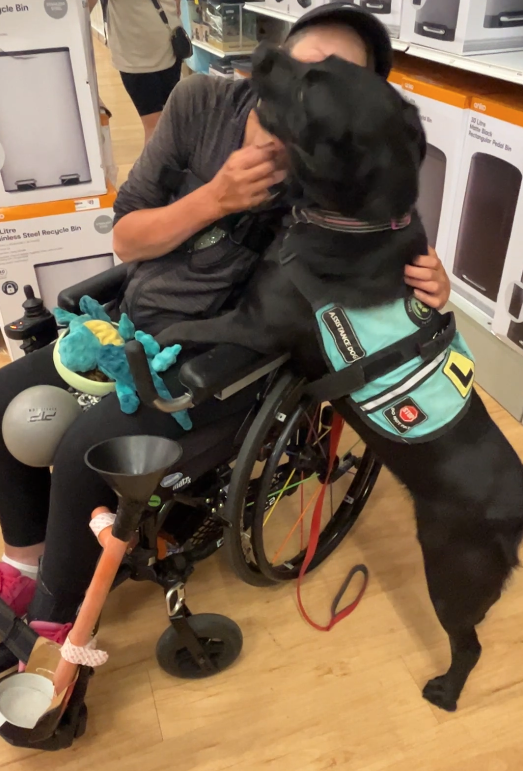Letting Go of Ruby: When an Assistance Dog Journey Takes a Different Path
Ruby
Giving hugs to her owner.
As an owner-trainer, one of the most difficult realities is recognising when a beloved dog isn't the right fit for assistance work. This is Ruby’s story; An owner-trainer’s perspective.
Letting Go
One of the hardest parts of being an owner-trainer of an assistance dog is facing the reality that not every dog, no matter how loved or well-prepared, is suited to the role. There are so many criteria that need to be met: emotional stability, focus in high-distraction environments, physical soundness, and a temperament that allows them to thrive under pressure. Sometimes, despite our best efforts and hopes, we have to make the heartbreaking decision to put the dog’s wellbeing and our own before the original plan. That’s exactly what happened with Ruby.
Early Signs and Growing Concerns
I had been concerned about Ruby’s reactions to other dogs for quite a while. I even took her to a training facility where there were lots of dogs around. She was perfect during the class: calm, attentive, and didn’t react to any of the other dogs. But as soon as we left and started the walk home, she would completely lose it when she saw another dog.
I spoke with Em at Paws for Assistance (PFA) about my concerns, and we arranged a training session at a dog park. Em shared some of the same worries, and Ruby made it clear: she wasn’t focused on us at all, just the other dogs. The hardest part was that she was meeting all the task criteria and general public access including helping me in the home with many things, but I just cannot keep another pet dog in the house.
A Turning Point
One day, I was walking with Ruby and we had to pass a lady pushing a pram, with a toddler walking behind her and a seven-month-old puppy in tow. We almost made it past them when Ruby couldn’t contain herself any longer. She darted in front of me, and her lead pressed against my wheelchair controller, I nearly ran into her!
That was the moment it really hit me: I couldn’t keep Ruby for the job I required; for my safety, and for hers. If I kept her, she would always need to be on-lead. No freedom to just be a dog.
A New Life for Ruby
After a lot of deliberation and emotional turmoil, I was fortunate to find a lovely home for her, a young man who was looking for a best friend. He sent me videos of her settling into her new life. One clip showed his four-year-old nephew walking Ruby through a park. She was so gentle and happy. Watching it made me sad. I wondered if I’d just held on, whether maturity would have helped her focus.
I questioned myself. Was I doing something wrong? Were my reflexes just not fast enough?
Then I received a text asking about Ruby’s reactions around other dogs. It turns out it wasn’t just me. Phew! That helped ease the guilt. I realise now that Ruby just wasn’t the right fit for the life I live from a wheelchair. I still catch myself wanting to text and ask how she’s going. But she’s not my dog anymore.
A Reflection for Others Walking This Road
To anyone else facing a similar decision: please know that letting go is not a failure. It’s one of the most compassionate and responsible things you can do for your safety, for the dog’s wellbeing, and for the future of your assistance dog journey. You are not alone. It takes courage to recognise when things aren’t working, and even more courage to act on that truth. The love doesn’t go away, it just finds a different shape.
Not My Dog.
My house is so quiet visitors have noticed it’s very quiet “ no more dog”
I sit here at night and watch TV then I get bored and I look around the room “ no more dog”
I used to play games with Ruby, tug-of-war and chasing balls in the lounge room “ no more dog”
My poor cats are sick of me. I’m always trying to get them to play now. They stop after about 10 minutes. Ruby didn’t stop for hours.
We used to go for long walks, My other dog is too old now and only goes slow and not too far.
We used to practice our training and tricks at night.
I look at all the videos and photos and feel sad.
I wake up in the morning and there is no dog looking at me and licking my face and wanting a belly rub “ no more dog”. K.B.

